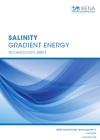

Salinity Gradient Energy: Technology brief
Newsletter
This brief examines salinity gradient energy technologies, one of the key methods for tapping renewable energy from the world’s oceans.
Salinity gradient power is the energy created from the difference in salt concentration between two fluids, commonly fresh and salt water, e.g., when a river flows into the sea. There are two technologies for which demonstration projects are running and both use membranes. The compartments between the membranes are alternately filled with sea water and freshwater. The salinity gradient difference is the driving force in transporting ions that results in an electric potential, which is then converted to electricity.
This brief forms part of a set by the International Renewable Energy Agency (IRENA) covering four main types of ocean energy technologies: Ocean Thermal, Tidal, Wave and Salinity Gradient energy.
Successive technology briefs have highlighted a wide range of renewable energy solutions. Each brief outlines technical aspects, costs, market potential and barriers, combined with insights for policy makers on how to accelerate the transition to renewables.




